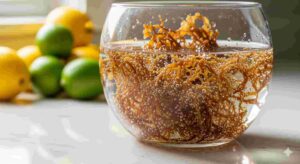
I’ll admit it—I first tried sea moss not because I was chasing better recovery or superfood bragging rights, but because a friend warned me: “Careful, it’ll send you running to the bathroom.” Naturally, I had to see if it was true. Spoiler: I spent part of that day a little too familiar with my bathroom tiles. But here’s the thing—once I understood why sea moss has this effect, it actually became one of my favorite natural additions for gut health and recovery.So let’s settle the burning question: does sea moss make you poop? Short answer—yes, it can.
But the real story is a lot more interesting, and a whole lot more useful if you’re into fitness, nutrition, and staying regular without relying on chemical-heavy fixes.
Why Does Sea Moss Make You Poop?
Sea moss is rich in soluble fiber. When you eat it, that fiber swells in your gut, pulling in water and softening stools. The result? Smoother, easier bathroom trips.
But it’s not just about laxative-like effects. The mucilaginous (that gel-like texture) nature of sea moss also coats the digestive tract. This can soothe irritation, help with constipation, and even support good gut bacteria.
For me, it felt like my body’s “reset button” when digestion slowed down after a week of protein shakes and meal prep chicken. It’s not harsh like some laxatives—it’s more of a gentle nudge.
Can Sea Moss Help With Constipation Relief?
If you’ve been sitting uncomfortably after back-to-back workouts, wondering why your high-protein diet isn’t moving smoothly, sea moss might be the fix. Constipation often comes from too much protein, too little fiber, and not enough hydration. Sea moss tackles two of those issues at once—fiber and water retention.
I’ve noticed it works best when paired with enough fluids. Sea moss on a dry stomach won’t do much. But toss it into a smoothie with water-rich fruits like pineapple or mango, and you’ve got a natural digestive assist that works within a day or two.
Does Sea Moss Work the Same for Everyone?

Here’s where it gets tricky. Some people swear it clears them out within hours, while others barely notice a difference. The answer depends on your current diet.
- High-fiber eaters: If you’re already eating a ton of greens, oats, and whole grains, sea moss won’t feel dramatic.
- Low-fiber eaters: If your diet leans protein-heavy, processed, or fast food-based, the effect may feel like hitting the fast-forward button.
For me, consistency is the key. Taking small amounts of sea moss daily keeps digestion smooth without any urgent bathroom emergencies.
How Do You Use Sea Moss Without Overdoing It?
This is the golden question because yes, too much sea moss can send you running.
- Start small: 1–2 tablespoons of sea moss gel daily is plenty.
- Pair with hydration: Think of it like oatmeal—fiber without water just clogs things up.
- Blend smart: Add it into smoothies, teas, or even soups. The gel is basically flavorless, so it won’t ruin your recipe.
When I first experimented, I made the rookie mistake of tossing in half a cup. That’s not a power move—it’s a bathroom marathon. Ease in, and your gut will thank you.
How-To: Use Sea Moss for Better Digestion
Here’s the practical, no-fluff guide to making it work for you:
- Prepare the gel – Soak raw sea moss overnight, rinse, then blend with water until smooth. Store in a jar in the fridge.
- Daily dose – Take 1–2 tablespoons in the morning, either straight or mixed into a smoothie.
- Stay hydrated – Drink at least 8–10 glasses of water that day. The fiber needs liquid to do its job.
- Track results – Notice how your digestion changes. If you’re running to the bathroom too often, scale back.
Think of it as a supplement, not a meal replacement. You want steady digestive support, not a sprint.
Does Sea Moss Only Make You Poop, or Are There Other Benefits?

While we’re talking gut health, it’s worth mentioning that sea moss isn’t just a “bathroom booster.” It’s loaded with iodine for thyroid health, potassium for muscle recovery, and antioxidants for overall wellness.
I like it most for how it fits into recovery. After intense leg day sessions, I’m usually sore, dehydrated, and a bit backed up. Sea moss helps me bounce back faster, keeps my digestion on track, and makes hitting workouts back-to-back much easier.
FAQs
Q1: How fast does sea moss make you poop?
For most people, the effect kicks in within 24 hours. If your system is sluggish, you might notice relief even faster. But it’s not like a harsh laxative—think of it as smoother, more regular bathroom visits instead of sudden urgency.
Q2: Can sea moss cause diarrhea?
Yes, if you take too much. Remember, it’s high in fiber. Overloading your system can lead to loose stools. Stick to 1–2 tablespoons daily until you know how your body reacts.
Q3: Is sea moss safe to take every day?
Generally, yes. Just don’t go overboard. Like any supplement, moderation is key. A small daily amount can support digestion, thyroid health, and recovery. But if you notice bloating or discomfort, take a break.
Q4: Does sea moss make you poop more than other fibers?
It’s not necessarily stronger than things like chia seeds or psyllium husk. The difference is in texture—its gel-like consistency makes digestion smoother and easier. Many people find it gentler than traditional fiber supplements.
The Bottom Line: Sea Moss and Bathroom Breaks
So, does sea moss make you poop? Absolutely. But it’s not just about bathroom trips—it’s about digestive support, smoother recovery, and better overall health. Think of it as nature’s way of keeping your gut moving without harsh chemicals.
For me, it’s become a small but mighty part of my fitness routine. It helps me stay consistent with training, recover faster, and keep my nutrition plan on track without those uncomfortable digestion slowdowns.
If you try it, start small, stay hydrated, and let your body adjust. Trust me—your gut (and your bathroom schedule) will thank you.


